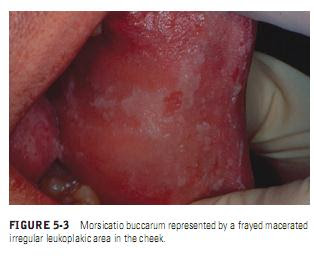White lesions of the oral tissues may result from chronic irritation due to repeated sucking, nibbling, or chewing.
These insults result in the traumatized area becoming thickened, scarred, and paler than the surrounding tissues.
Cheek chewing is most commonly seen in people who are under stress or in psychological situations in which cheek and lip biting become habitual. Most patients with this condition are somewhat aware of their habit but do not associate it with their lesions. The white lesions of cheek chewing may sometimes be confused with other dermatologic disorders involving the oral mucosa, which can lead to misdiagnosis.These insults result in the traumatized area becoming thickened, scarred, and paler than the surrounding tissues.
Chronic chewing of the labial mucosa (morsicatio labiorum) and the lateral border of the tongue (morsicatio linguarum) may be seen with cheek chewing or may cause isolated lesions. Prevalence rates ranging from 0.12 to 0.5% have been reported in Scandinavian populations, compared with a prevalence rate of 4.6% for South African school children in mental health treatment facilities; these rates support the role of stress and anxiety in the etiology of this condition.
TYPICAL FEATURESThe lesions are most frequently found bilaterally on the posterior buccal mucosa along the plane of occlusion. They may be seen in combination with traumatic lesions on the lips or tongue. Patients often complain of roughness or small tags of tissue that they actually tear free from the surface. This produces a distinctive frayed clinical presentation (Figure 5-3). The lesions are poorly outlined whitish patches that may be intermixed with areas of erythema or ulceration. The occurrence is twice as prevalent in females and three times more common after the age of 35 years.
The histopathologic picture is distinctive and includes hyperparakeratosis and acanthosis. The keratin surface is usually shaggy and ragged with numerous projections of keratin that demonstrate adherent bacterial colonies. When the lesion is seen on the lateral tongue, the clinical and histomorphologic features mimic those of oral hairy leukoplakia.
TREATMENT AND PROGNOSIS
Since the lesions result from an unconscious and/or nervous habit, no treatment is indicated. However, for those desiring treatment and unable to stop the chewing habit, a plastic occlusal night guard may be fabricated. Isolated tongue involvement requires further investigation to rule out oral hairy leukoplakia especially when appropriate risk factors for infection with human immunodeficiency virus (HIV) are present. Differential diagnosis also includes WSN, chemical burns, and candidiasis.
Since the lesions result from an unconscious and/or nervous habit, no treatment is indicated. However, for those desiring treatment and unable to stop the chewing habit, a plastic occlusal night guard may be fabricated. Isolated tongue involvement requires further investigation to rule out oral hairy leukoplakia especially when appropriate risk factors for infection with human immunodeficiency virus (HIV) are present. Differential diagnosis also includes WSN, chemical burns, and candidiasis.
